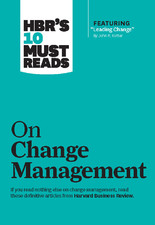 Authors: John P. Kotter, David A. Garvin, Michael A. Roberto, Paul Hemp, Thomas A, Stewart, Debra E. Meyerson, W. Chan Kim, Renee Mauborgne, Ronald A. Heifetz, Marty Linsky, Robert Kegan, Lisa Laskow Lahey, Michael Beer, Nitin Nohria, Harold L. Sirkin, Perry Keenan, Alan Jackson, Russell Eisenstat and Bert Spector
Authors: John P. Kotter, David A. Garvin, Michael A. Roberto, Paul Hemp, Thomas A, Stewart, Debra E. Meyerson, W. Chan Kim, Renee Mauborgne, Ronald A. Heifetz, Marty Linsky, Robert Kegan, Lisa Laskow Lahey, Michael Beer, Nitin Nohria, Harold L. Sirkin, Perry Keenan, Alan Jackson, Russell Eisenstat and Bert Spector
Publisher: Harvard Business Review Press – 210 pages
Book Review by: Sonu Chandiram
We have read often that growth cannot occur without change. Human beings typically resist change because it takes them out of their comfort zone. Most people want to stay in their comfort zone. This is why there are so many ordinary people and few extraordinary ones who have achieved high levels of success.
If you read histories of companies that became very large, there were momentous events that occurred that brought about change which engendered great growth – in revenues, and profitability, in efficiencies and effectiveness, and in increased customer satisfaction.
In the initial article in this book, “Leading Change” (also featured on the book cover), the author John P. Kotter writes that in the past decade he has watched more than 100 companies try to remake themselves into significantly better competitors.
Among the ones who have tried to transform themselves are large companies such as Ford, small ones like Landmark Communications, U.S.-based firms (General Motors) those overseas (British Airways), corporations that were on the brink of oblivion (Eastern Airlines) and even those that were making good money (Bristol-Meyers Squibb).
The types of changes that firms were trying to achieve were: cultural change, reengineering, restructuring, rightsizing, total quality management and turnaround. Some succeeded, many utterly failed, and most fell somewhere in between.
Kotter explains that the reason for the high failure rate is that managers do not realize that change is not an event with a finality but a process that brings about transformation gradually, building upon past improvements, with the end result that is dramatically better than the beginning. It takes years to bring about significant change, and shortcuts never work, he points out.
One of the difficulties in bringing about meaningful transformation is that communicating effectively with the people involved – especially when there are a lot of people – is no easy task. It takes the right type of messages to get buy-in.
Kotter enumerates and discusses eight steps to transforming an organization:
- Establishing a sense of urgency
- Forming a powerful guiding coalition
- Creating a vision
- Communicating the vision
- Empowering others to act on the vision
- Planning for a creating short-term wins
- Consolidating improvements and producing still more change
- Institutionalizing new approaches.
He presents a chart with the actions needed and the potential pitfalls for each of these steps, which are actually stages in the transformation process.
In each such book (as readers may have noted in the reviews of two other books in the Harvard Business Review series on business) there are 10 articles on different topics written by various people. The other nine articles have each to do with some aspect or type of change.
David A. Garvin and Michael A. Roberto write on change through persuasion; Paul Hemp and Thomas A. Stewart have written the remarks of Samuel J. Palmisano, former CEO of IBM taken from an interview.
Debra E. Meyerson discusses radical change “the quiet way.” W. Chan Kim and Renee Mauborgne write on tipping point leadership; Ronald A. Heifetz and Marty Linsky present a “survival guide” for leaders; and the real reasons people won’t change are revealed by Robert Kegan and Lisa Laskow Lahey.
Michael Beer and Nitin Nohra help you “crack the code of change” while Harold L. Sirkin, Perry Keenan and Alan Jackson show you a view of the hard side of management.
Finally, Michael Beer, Russell Eisenstat and Bert Spector explain “Why Change Programs Don’t Produce Change.”
As with other books in HBR’s 10 Must-Reads series, this is an excellent book wherein the articles are very enlightening. They have been chosen from hundreds of articles that appeared in the Harvard Business Review.







